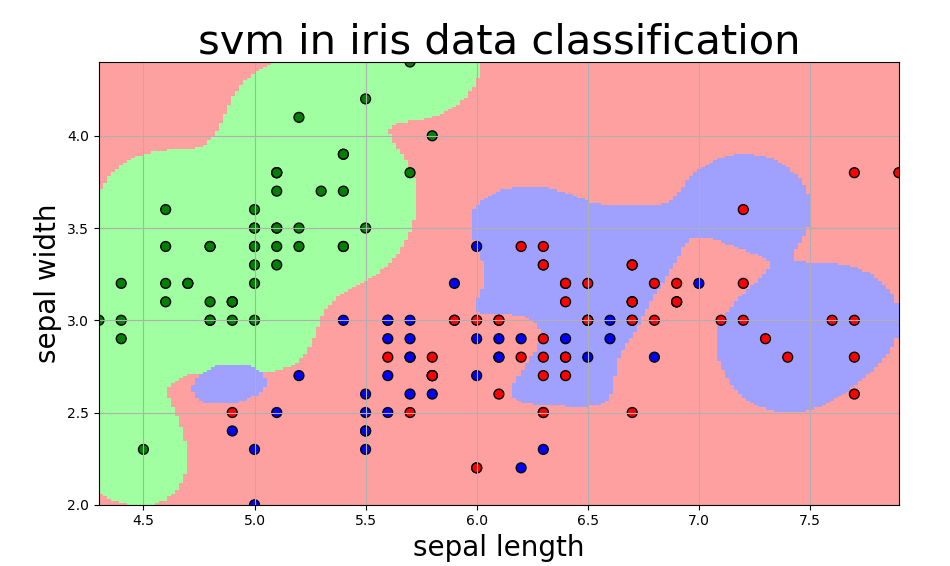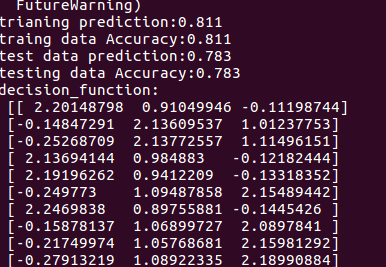code:
import numpy as np
import pandas as pd
from sklearn import svm
from sklearn.model_selection import train_test_split
import matplotlib as mpl
import matplotlib.pyplot as plt
def iris_type(s):
# python3读取数据时候,需要一个编码因此在string面前加一个b
it = {b'Iris-setosa':0, b'Iris-versicolor':1, b'Iris-virginica':2}
return it[s]
iris_feature = 'sepal length', 'sepal width', 'petal lenght', 'petal width'
def show_accuracy(a, b, tip):
acc = a.ravel() == b.ravel()
print('%s Accuracy:%.3f' %(tip, np.mean(acc)))
if __name__ == '__main__':
# 加载数据
iris_feature = 'sepal length', 'sepal width', 'petal lenght', 'petal width'
'''
# 方法1:通过pandas读取数据
data = pd.read_csv('iris.data', header=None)
iris_type = data[4].unique()
for i, type in enumerate(iris_type):
data.set_value(data[4] == type, 4, 1)
# print('--------------------------')
# print(data)
'''
# 方法2:numpy读取
data = np.loadtxt('iris.data', dtype=float, delimiter=',', converters={4:iris_type})
x, y = np.split(data, (4,), axis=1)
# y = y.reshape((-1))
# print(x)
print('--------------------------')
# print(y.ravel())
x = x[:, :2]
x_train, x_test, y_train, y_test = train_test_split(x, y, random_state=1, train_size=0.6)
# print(x_train)
# print('--------------------------')
# print(y_train.ravel())
# 分类器
# 高斯核
# clf = svm.SVC(C=0.8, kernel='rbf', gamma=50, decision_function_shape='ovr')
# 线性核
clf = svm.SVC(C=0.5, kernel='linear', decision_function_shape='ovr')
clf.fit(x_train, y_train.ravel())
# 中间结果的输出
print('trianing prediction:%.3f' %(clf.score(x_train, y_train)))
# 预测值
y_hat = clf.predict(x_train)
show_accuracy(y_hat, y_train, 'traing data')
print('test data prediction:%.3f' %(clf.score(x_test, y_test)))
y_hat_test = clf.predict(x_test)
show_accuracy(y_hat_test, y_test, 'testing data')
# decision function
print('decision_function:\n', clf.decision_function(x_train))
# print('\npredict:\n', clf.predict(x_train).reshape(-1, 1))
print('\npredict:\n', clf.predict(x_train))
# 开始画图
x1_min, x1_max = x[:, 0].min(), x[:, 0].max()
x2_min, x2_max = x[:, 1].min(), x[:, 1].max()
# 生成网格采样点
x1, x2 = np.mgrid[x1_min:x1_max:200j, x2_min:x2_max:200j]
# 测试点
grid_test = np.stack((x1.flat, x2.flat), axis=1)
print('grid_test:\n', grid_test)
# 输出样本到决策面的距离
z = clf.decision_function(grid_test)
print('the distance to decision plane:\n', z)
# 预测分类值
grid_hat = clf.predict(grid_test)
print('grid_hat:\n', grid_hat)
# reshape grid_hat和x1形状一致
grid_hat = grid_hat.reshape(x1.shape)
cm_light = mpl.colors.ListedColormap(['#A0FFA0', '#FFA0A0', '#A0A0FF'])
cm_dark = mpl.colors.ListedColormap(['g', 'b', 'r'])
plt.pcolormesh(x1, x2, grid_hat, cmap=cm_light)
# 样本点
plt.scatter(x[:, 0], x[:, 1], c=np.squeeze(y), edgecolor='k', s=50, cmap=cm_dark)
# 测试点
plt.scatter(x_test[:, 0], x_test[:, 1], s=120, facecolor='none', zorder=10)
plt.xlabel(iris_feature[0], fontsize=20)
plt.ylabel(iris_feature[1], fontsize=20)
plt.xlim(x1_min, x1_max)
plt.ylim(x2_min, x2_max)
plt.title('svm in iris data classification', fontsize=30)
plt.grid()
plt.show()
使用高斯核函数:
使用线性核函数:
输出中的decision function跟svm包中的svn函数参数decision_function_shape有关。ovo相当于把多分类问题分割为二分类问题求解,ovr相当于同时训练k个特征的分类器,然后把每个新的数据输入到分类器中,取得分最高的那个认定为属于该分类,有点像KNN思想。



